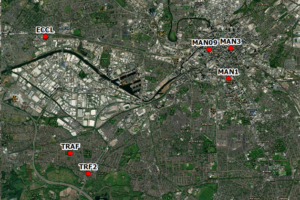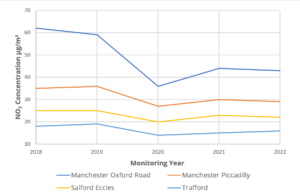This website uses cookies so that we can provide you with the best user experience possible. Cookie information is stored in your browser and performs functions such as recognising you when you return to our website and helping our team to understand which sections of the website you find most interesting and useful.
Like many large cities throughout the UK, Manchester has been subjected to poor air quality for several years, facing the challenges associated with trying to reduce atmospheric pollutants.
Air pollution in and around Manchester is generated from a range of sources, including Manchester airport, rail transport, industrial processes and the many active construction sites throughout the city. However, road traffic is by far the largest contributor to the major pollutants of concern, nitrogen dioxide (NO2) and particulate matter (comprising of microscopic dust particles from various airborne components which could affect health, commonly referred to as PM10 and PM2.5), with the elevated concentrations of these pollutants being strongly correlated to areas with high traffic volumes.
Manchester’s air pollution levels have fluctuated over the last several years, with an overall decline in pollutant concentrations, however, it is important to acknowledge that the impact of COVID-19 has also played a major role in recent years. A considerable drop in pollutant concentrations was observed in 2020 due to the impacts of travel restrictions in response to the COVID-19 pandemic, gradually rising back up in the following years.
Manchester City Council had previously proposed a Clean Air Zone similar to the Ultra Low Emissions Zone (ULEZ) in London, where vehicles which produce pollutant emissions above a certain threshold must pay a charge if entering the low emissions zone. However, the proposals for a fee-charging clean air zone in Manchester were paused in February 2022, with Andy Burnham (Greater Manchester Mayor) stating that improving air quality was a priority for Greater Manchester, but a clean air charging zone was not the best way forward.
The non-charging clean air zone instead proposes to improve air quality by increasing the number of electric buses, providing grants to taxis from a fund of over £22 million and accelerating investment in Manchester’s public transport system (the “Bee Network”).
Manchester City Council, along with neighbouring Trafford and Salford, use a variety of techniques to monitor air pollutant levels throughout the city, primarily employing the use of automatic (continuous) monitors and passive diffusion tubes. Based on data collected using continuous monitors over the last five years at various locations in the area, it is apparent that there was an overall decline in pollutant concentrations between 2018 and 2022. The data also show much improved air quality during 2020 and 2021, when travel was disrupted or prohibited during the Covid-19 pandemic and vehicle emissions consequently fell.


With air pollution still high on the agenda and with improvements being driven to meet statutory air quality objectives, Manchester City Council are working on several steps to help ensure this, as detailed within their Air Quality Action Plan. These are:
- Helping develop a Greater Manchester-wide investment-led Clean Air Plan to tackle road-based air pollution
- Developing the Bee Network to make it safer, easier and more appealing to walk and cycle in the city
- Increasing air quality awareness programmes to encourage people to take action against air pollution
- Improving traffic flow to reduce congestion and idling on key routes into the city
- Working more with schools to support walking/cycling, anti-idling, and trialling ‘green screens’ around playgrounds
- Promoting the contribution of green infrastructure across the city
- Introducing tighter controls on taxi emissions
- Scrutinising planning applications to ensure air quality impacts are mitigated
Environmental consultancies like Temple play an important role in facilitating the continued improvement of air quality in Manchester. With our strong presence in the northwest, Temple can offer bespoke air quality assessments for a wide range of developments throughout the city, providing expert advice on how emissions can be minimised. This often relates to helping developers to control dust and particulate matter emissions from construction sites, by advising on the optimal equipment and strategies for specific sites. This is especially important for sites located in areas with already poor existing air quality, such as Manchester city centre. This may also involve Temple undertaking continuous air quality monitoring at many construction sites, with the ability to identify exceedances in real-time, enabling Temple to inform developers so that site operators can take immediate action to mitigate emissions. Additionally, Temple can deliver bespoke training to help educate both the public and professionals on issues surrounding air quality.
